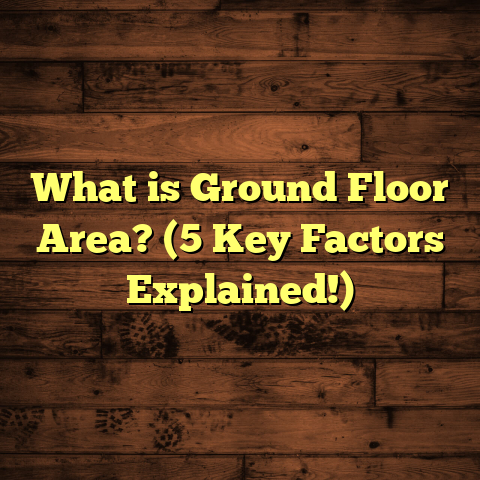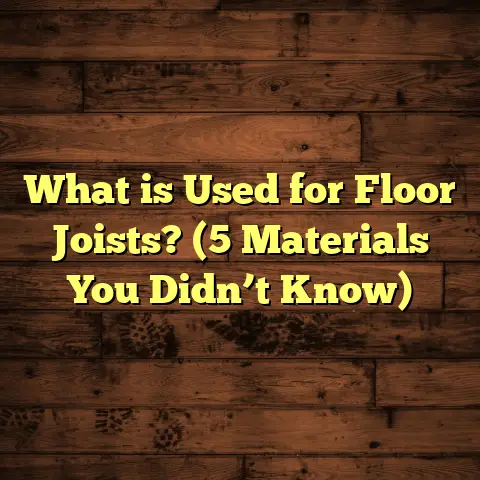What is Fix a Floor Made Of? (5 Key Materials Explained!)
When I first started working in flooring, one of the main things I learned quickly was that no two rooms are alike when it comes to what their floors need. A bedroom might call for something soft and warm, while a laundry room demands waterproof, durable materials. This means the materials you use to fix or install a floor depend heavily on where the floor will be and how it will be used.
What Is Fix a Floor Made Of?
At its simplest, “fix a floor” refers to the materials and layers that make up a floor, especially when repairing or installing it. Floors aren’t just what you see on top—there’s a whole system beneath that supports the surface and keeps it looking good and feeling stable for years.
When I say “fix a floor,” I’m talking about everything from the base material that holds up the floor to the finish layer you walk on. Fixing a floor often involves repairing or replacing these materials, or sometimes starting fresh by layering new components.
Let me break down five key materials you’ll find when fixing or building floors. Each one has unique properties, installation needs, and maintenance tips that can make your flooring project easier or harder depending on how well you understand them.
1. Concrete: The Bedrock of Many Floors
Concrete is often the first layer you encounter under many floors. It’s tough, durable, and versatile. In my early days working on renovations, I saw how important a good concrete slab can be. One job had us pull up worn-out tile to find a cracked concrete base underneath — without fixing that slab first, nothing we put on top would last.
Why Concrete?
Concrete is basically cement, sand, gravel, and water mixed together and hardened into a rock-like surface. It’s usually poured onsite to form slabs or foundations. Concrete is excellent for supporting heavy loads and is resistant to pests like termites.
Where You’ll Find It:
Basements, garages, kitchens, and sometimes living rooms have concrete slabs as their base. Concrete is ideal where moisture might be an issue because it doesn’t rot like wood.
Installation Tips:
Pouring concrete requires precision. It needs to be level and smooth; otherwise, your finished floor will feel uneven or look bumpy. After pouring, concrete takes time to cure—usually around 28 days to reach full strength. You might need to add a vapor barrier underneath to prevent moisture from seeping up into your floor.
Maintenance:
Concrete floors are low maintenance but can crack if the ground shifts or if there’s poor drainage around your home. Sealing concrete every few years protects it from stains and water damage.
My Experience:
One time on a kitchen remodel, we found the concrete slab had settled unevenly over decades. We used a self-leveling compound to smooth it before laying tile. Without that step, tiles would have cracked or popped loose quickly.
Data Point:
The Portland Cement Association reports that well-maintained concrete floors can last over 50 years. Some commercial floors last even longer due to their thickness and sealing.
2. Plywood Subfloor: The Flexible Backbone for Wood Floors
When hardwood or laminate floors go down, they usually lie on top of plywood subfloors. I learned this piece early on—if your plywood subfloor isn’t right, your wood floor will squeak, gap, or even buckle.
What Is Plywood Subfloor?
Plywood is made by gluing thin layers of wood veneer together with grains running perpendicular for strength. It’s lighter than concrete but still rigid enough to support floors above.
Where It’s Used:
Plywood subfloors go over floor joists in wood-framed houses or over concrete slabs when paired with moisture barriers. Most homes with wooden floors have plywood underneath.
Installation Tips:
Plywood sheets come in standard 4×8 foot sizes and are usually ¾ inch thick for subfloors. They’re nailed or screwed down tightly to joists or sleepers atop concrete.
One thing I always recommend is checking for moisture before installation—wet plywood can warp quickly.
Maintenance:
Once covered by flooring, plywood needs little upkeep besides avoiding water exposure. If water gets underneath, it can swell or rot.
Personal Story:
I remember working on a basement remodel where the client wanted engineered hardwood over concrete. We installed a plywood subfloor with a moisture barrier to prevent the wood from warping due to basement humidity. That extra step saved them from costly repairs later.
Data Point:
Plywood subfloors generally cost between $1-$3 per square foot installed but add essential stability for finished floors.
3. Hardwood Flooring: Natural Beauty and Durability
Hardwood floors have been around for centuries and remain popular for good reason—they’re elegant, sturdy, and add value to any home.
What’s Hardwood Flooring?
Solid hardwood flooring consists of planks cut from trees like oak, maple, cherry, or walnut. Each plank is one solid piece of wood.
Where Hardwood Shines:
Living rooms, bedrooms, dining rooms—places where you want warmth underfoot and timeless style.
Installation Details:
Hardwood floors are nailed or glued down over plywood subfloors or concrete (with appropriate underlayment). Before installation, wood planks acclimate in the room for days to adjust to humidity levels.
Maintenance:
Hardwood needs regular sweeping to avoid scratches from grit. Every 7-10 years, refinishing can restore its original sheen by sanding off the surface layer.
Challenges:
Wood reacts to moisture—it can swell or shrink with humidity changes. Spills should be cleaned fast to avoid stains or warping.
Personal Insight:
On one project in a historic home, we installed reclaimed oak hardwood floors. The wood had character with knots and grain patterns but showed scratches easily. We recommended area rugs in high-traffic spots to protect their look.
Data Point:
According to the National Wood Flooring Association (NWFA), hardwood floors can last more than 100 years with proper care and refinishing.
4. Vinyl Flooring: Practical and Stylish
Vinyl has evolved dramatically since I first saw it decades ago in cheap apartments. Today’s luxury vinyl tiles (LVT) offer designs that mimic wood and stone closely while being waterproof and budget-friendly.
What Is Vinyl Flooring?
Vinyl is a synthetic flooring made from polyvinyl chloride (PVC) with layers that include a protective wear layer and a printed design layer.
Best Uses:
Kitchens, bathrooms, basements—anywhere spills are common or moisture is present.
Installation:
Vinyl can be glued down or installed as floating floors over plywood or concrete. It’s easier than hardwood or tile and quicker to install.
Maintenance:
Vinyl cleans up easily with sweeping and mopping; it resists stains well and doesn’t need refinishing.
My Experience:
I installed vinyl planks in a rental property’s kitchen once. The landlord loved how quickly we completed the job while tenants appreciated its easy cleaning after cooking messes.
Data Point:
Vinyl floors typically last 10-20 years but can exceed that with good care. The cost ranges from $2-$7 per square foot installed.
5. Tile: Durable and Design-Forward
Tile floors have been around since ancient times but remain popular because of their durability and clean look—especially in wet areas.
What Is Tile Flooring?
Tile includes ceramic and porcelain varieties made from fired clay with glaze coatings for durability and water resistance.
Ideal Rooms:
Bathrooms, kitchens, mudrooms—areas exposed to water or heavy foot traffic.
Installation:
Tiles are set into mortar over concrete or plywood subfloors with grout filling joints between tiles.
Proper leveling during installation prevents uneven edges (called lippage), which can be annoying underfoot.
Maintenance:
Tiles themselves are easy to clean but grout lines need sealing every couple of years to prevent stains and mildew buildup.
Personal Story:
On one bathroom renovation, we chose large-format porcelain tiles that visually enlarged a small space. However, large tiles require very flat subfloors—our team spent extra time leveling before installation to avoid unevenness later on.
Data Point:
Tile flooring can last 40+ years if maintained properly. Installation costs range from $7-$15 per square foot depending on tile quality and labor complexity.
How These Materials Work Together
It’s helpful to think of flooring as layers working together:
- Concrete slab → vapor/moisture barrier → plywood subfloor → hardwood floor
- Concrete slab → mortar bed → tile
- Plywood subfloor → underlayment → vinyl plank
Each layer plays a role:
- Concrete: Strength and moisture barrier
- Plywood: Stability and flexibility
- Flooring Material (Hardwood/Vinyl/Tile): Aesthetic surface and wear layer
Installation Tips From My Years on the Job
I’ve learned some hard lessons installing floors:
- Prep Thoroughly: Uneven or moist bases lead to squeaks, cracks or buckling.
- Manage Moisture Well: Especially with wood flooring over concrete.
- Use Proper Tools: Self-leveling compounds for uneven slabs; moisture meters; vapor barriers.
- Hire Pros When Needed: Some floors like tile require skill you don’t want to guess on.
- Allow Time for Acclimation: Wood flooring should sit in the room before installation for days.
- Test Subfloor Stability: Check for movement or softness before installing finish layers.
- Plan Waste Factor: Always order extra material (5-10%) for cuts and mistakes; I’ve saved clients from last-minute runs by this simple step.
Maintenance Tips That Keep Floors Beautiful Long-Term
- Sweep or vacuum regularly.
- Use doormats at entrances.
- Wipe spills immediately on wood/vinyl.
- Refinish hardwood every 7-10 years.
- Seal grout lines every few years.
- Avoid harsh chemical cleaners that degrade finishes.
- Use furniture pads under legs to prevent scratches.
- For tile: check grout condition yearly; repair cracks promptly.
- For vinyl: don’t use abrasive scrubbing pads; mop with mild cleaner only.
Cost Considerations: What You Can Expect
Here’s a quick look at average installed costs per square foot for these materials:
| Material | Cost per Sq Ft Installed | Lifespan (Years) | Maintenance Notes |
|---|---|---|---|
| Concrete | $3 – $8 | 50+ | Seal every 3-5 years |
| Plywood | $1 – $3 | N/A (base layer) | Keep dry |
| Hardwood | $8 – $15 | 75 – 100+ | Refinish every 7-10 years |
| Vinyl | $2 – $7 | 10 – 20 | Easy cleaning required |
| Tile | $7 – $15 | 40+ | Reseal grout every 2 years |
Case Study: Fixing a Kitchen Floor Over Concrete Slab
A client reached out wanting beautiful hardwood in their kitchen—but the existing floor was an old concrete slab showing cracks and moisture issues.
Our Approach:
- Measured moisture using meters—too high for direct hardwood.
- Installed vapor barrier atop slab.
- Laid plywood subfloor over vapor barrier.
- Installed engineered hardwood planks nailed down to plywood.
Two years later they reported no warping or squeaks despite cooking messes and occasional water splashes—a problem avoided thanks to proper layering and moisture control upfront.
My Final Thoughts
If you’re thinking about fixing or installing floors yourself or hiring someone, knowing what goes into the floor beneath your feet helps you ask better questions—and avoid costly mistakes down the road.
Each material I described has its place based on your room’s needs—whether it’s strong concrete bases in basements or warm hardwood in living rooms—and understanding installation plus maintenance makes your floors last longer and feel better every day.
What kind of floor do you see fitting your space best? If you want tips tailored to your home or project questions answered, just ask—I’m happy to help!
Would you like me to walk through installation steps for any specific material next?





